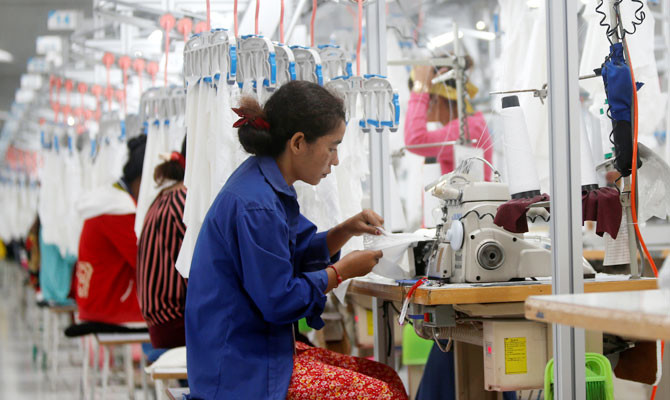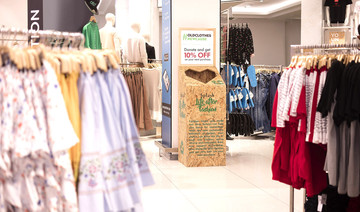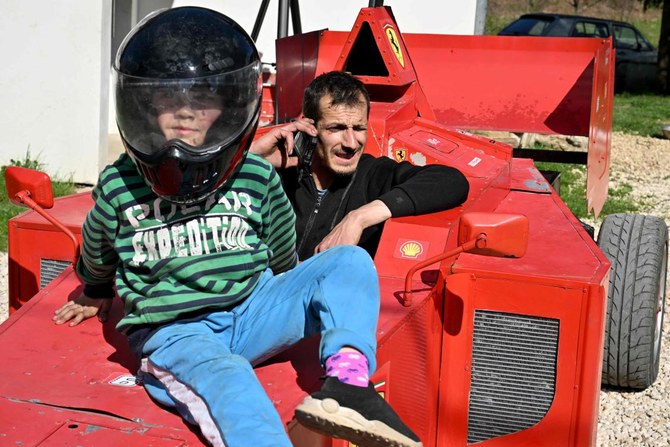PHNOM PENH: In an industry riddled with poor health, abuse and labor exploitation, Yim Srey Neang and her colleagues are pleased to have garment factory jobs that are relatively stable and safe.
They speak highly of their employers as representatives of 4,000 people toiling in a factory that supplies to fashion giant H&M from the outskirts of the Cambodian capital, Phnom Penh.
But when conversation turns to the so-called “fair living wage,” the tone shifts: several factory workers begin firing off laundry lists of life’s necessities — food, shelter, education, health care — and their prices in an onslaught of discontent.
“No, it’s not fair,” Srey Neang said on a tour of the factory organized by H&M, the world’s second biggest fashion retailer with more than 4,800 stories located in 71 countries.
“Our salary does not allow us to save money — it’s barely enough to live.”
Srey Neang is one of 1.6 million people worldwide working in factories that supply H&M — part of a global fashion industry that employs at least 60 million people — according to the United Nations’ International Labour Organization (ILO).
In an industry fueled by cheap labor — mainly young women — the concept of a fair living wage aims for workers to move beyond living from paycheck to paycheck, where a single accident or emergency can plunge a family into financial crisis.
In 2013, H&M pledged to overhaul its supply chain — seven months after poor conditions in the textile industry grabbed global attention when Rana Plaza, a seven-story commercial building in Bangladesh, collapsed — killing 1,130-odd people.
Consumers and campaigners demanded action, but five years on the Swedish retailer — which reported a profit after tax of about $1.8 billion for 2017 — is still wrestling with how to ensure a greater share goes to the workers making its clothes.
While wages are rising on factory floors worldwide, David Savman, H&M’s global head of production, said that the number of factory workers receiving a living wage remained at “zero.”
“Until workers’ unions and manufacturers agree on a figure, we do not know what a fair living wage is,” he told the Thomson Reuters Foundation during the factory visit.
Some observers call for individual brands to narrow focus and take direct action to increase wages in their own supply chain, but Savman said such an approach would be unsustainable.
“We don’t want to create an isolated bubble of fairness,” he said, adding that H&M wanted to see collective bargaining, where representatives of workers and employers negotiate a wage floor.
“We want to see frameworks put in place to raise standards across the entire industry — frameworks that will remain in a market after we pull out.”
NEW FASHIONED
H&M’s 2013 vow to tackle a problem that has been discussed for decades was a first for the textile industry — a five-year plan to overhaul pay structures and give workers more of a say.
Five years on, at their “Fair Living Wage Summit” in Phnom Penh last week, H&M reported that it had exceeded targets for workers who had been educated on how to earn more and for employees who could elect their representatives.
The Microfinance Organization, a US-based non-profit, surveyed 180 factory staff in Bangladesh — H&M’s second largest source market — and found that workers in the Swedish giant’s supply chain were earning more than workers in other factories.
Those workers reported spending $8 more on food each month, being less burdened by debt and in better health.
But at an average of 49 cents an hour, many staff in H&M’s supply chain were still earning hourly rates that violate Bangladeshi labor laws, and union membership was “almost non-existent across the full sample,” according to the study.
H&M says it wants workers at the negotiating table, head-to-head with factory bosses and without the influence of governments, whose interests generally lie in keeping wages low.
Factory bosses are rightfully fearful of this, Savman said, so H&M has committed to “ringfencing” a living wage — removing wages from their purchasing negotiations with factory owners and covering any fluctuations that occur.
“We want to insulate them from labor costs so that they are more confident to come to the table,” he said.
NO EXCUSES
Cambodia’s garment industry has been overhauled in recent years — with the monthly minimum wage set to rise to $182 next year from $61 in 2012.
Yet a survey of 41 garment workers by the Center for the Alliance of Labor and Human Rights found that while the average wage was significantly higher than the minimum, workers were still earning less than $1 an hour — and living month-to-month.
Moeun Tola, the charity’s executive director, called for major brands to stop making excuses and improve workers’ pay.
“If H&M really wants to pay a living wage, they can go directly to their supplier and make an agreement,” he said, adding that this could encourage competitors to follow suit.
A review of H&M’s tactics by the Ethical Trading Initiative, however, found that it could not be fully effective without an increase in workers’ bargaining ability at factory level, more transparent pay structures, and better purchasing practices.
William Conklin, Cambodia country head for the Solidarity Center, a US-based nonprofit promoting workers’ rights, said that while H&M deserved credit above other brands who were “doing nothing,” it now had the chance to be a “trend-setter.”
“So what if workers in their (H&M) factories are paid better than other factories? They’d have a steady supply of labor,” Conklin said. “It’s not an excuse for not moving ahead.”
The Asia Floor Wage Alliance, an advocacy group, has marked $480 as a fair monthly living wage in Cambodia, while a group of Cambodian unions have called for a $225 minimum wage from 2019.
“H&M can reject those figures, that’s fine, but they need to come up with a counter figure and act,” Tola said, pointing out that many workers in the country were living with no safety net.
“A garment workers only needs to have one accident or one serious illness in the family and the whole salary is gone,” he added. “They are very vulnerable. What happens next?”
































